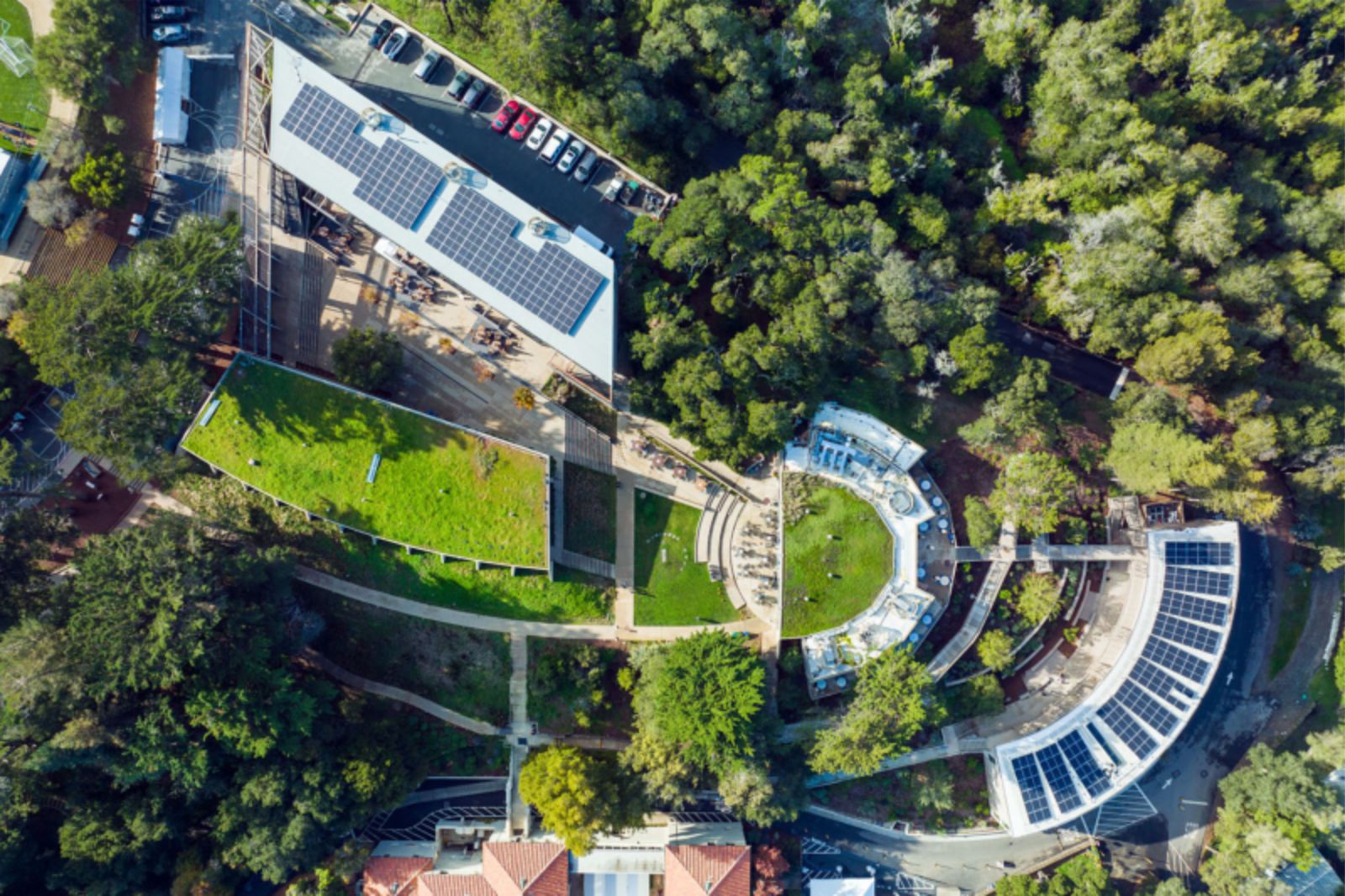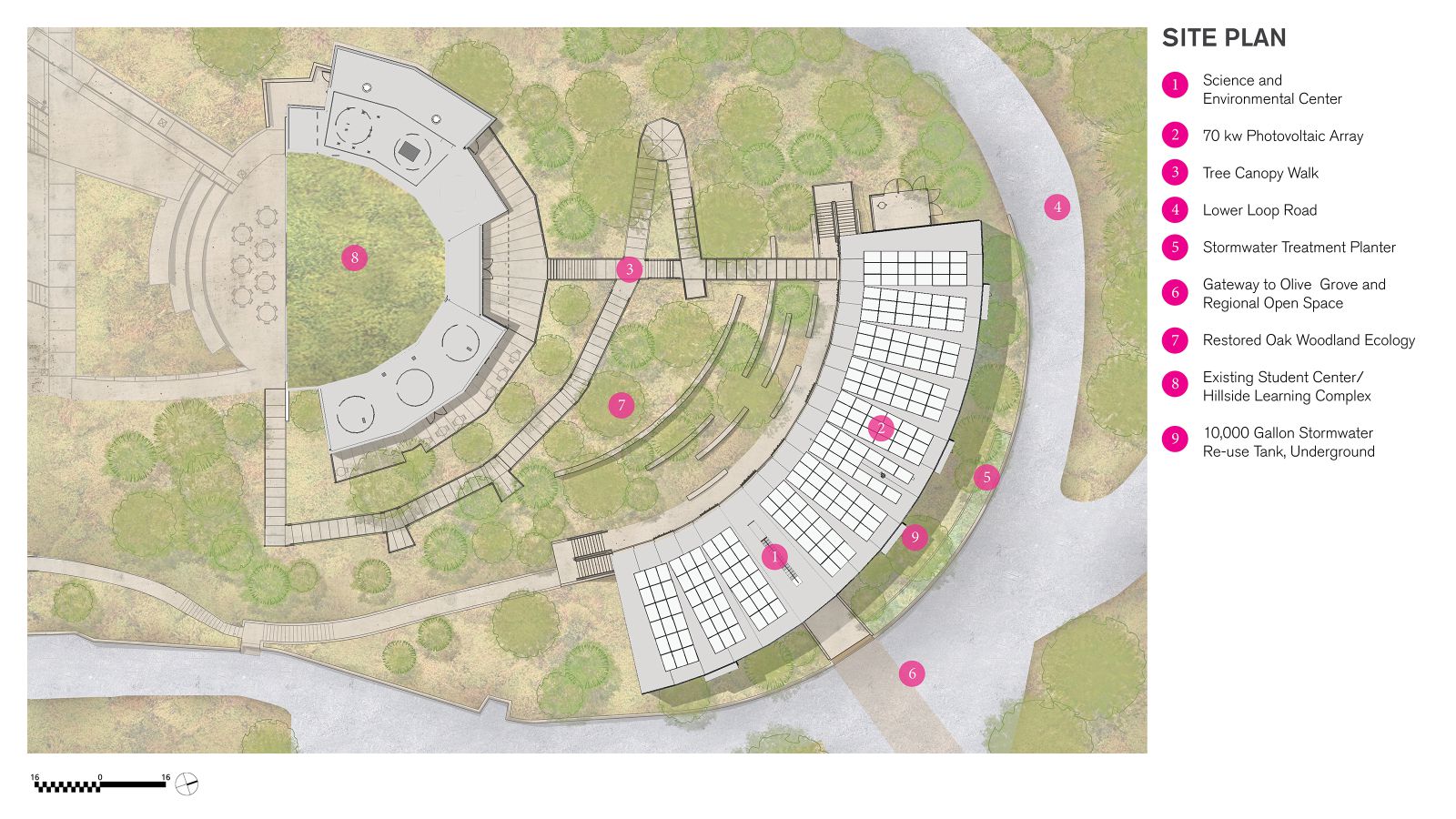The Science and Environmental Center embodies the Nueva School’s mission is to inspire passion for lifelong learning, foster social acuity and environmental citizenship, and develop the child’s imaginative mind, enabling students to learn how to make choices that will benefit the world. The 33-acre campus, located in the semi-rural coastal hills of the San Francisco Peninsula, features a thriving coastal live oak woodland ecosystem, a variety of dispersed structures and dramatic views of San Francisco Bay.
Ecology of Learning
The new school supports the school’s evolving mission of sustainability and environmental stewardship as a foundational pillar of student education. The project supports the school’s environmental citizenship program with eight science labs and associated support spaces that bring together pre-kindergarten through eighth grade classes to explore the interconnectedness of humans and the natural environment. Linked indoor and outdoor learning spaces serve as a living lab, where students practice sustainability, conduct environmental and social studies, and debate solutions to a broad range of environmental challenges.

Buildings that Teach
The project carefully weaves multiple sustainable strategies together, connecting school culture to place, creating education spaces that inspire lifelong learners while showing reverence for the natural world. The building is 100% electric and designed to be net zero operational energy/carbon, producing on-site all the energy it consumes annually. Its narrow floor plate allows for ample daylighting, views and natural ventilation, demonstrating how passive natural systems can reduce our need for energy.
In an era of more frequent and severe droughts, the building promotes advanced water conservation by harvesting rainwater in a 10,000-gallon storage tank for reuse in the building’s toilets, reducing potable water use by 89% compared to the baseline. A “Canopy Walk” links the existing Student Center at the heart of the campus to the new Environmental Center with a universally accessible educational path across the steep site. By using the Canopy Walk, all students—regardless of physical ability—may experience and explore the seasonal rhythms of the restored oak woodland ecology.

Process
The final program, building size, and location of the Environmental Center was finalized in 2015. The 11,600 SF building includes eight flexible environmental science classrooms with exterior learning spaces that support interdisciplinary learning. To meet the specific goals of the masterplan the project was designed for:
· Carbon Reduction: All electric building, zero net energy / zero net carbon:
· Water Conservation: Reduce potable water use in the building by at least 70%;
· Habitat Preservation and Restoration: Preserve and enhance access to campus and regional open space;
· Resiliency: Provide flexible and adaptable educational environments that support evolving pedagogies and expanding community outreach programs in earthquake and wildfire safe construction.

Weaving Together
The building shape echoes the landform, following the topography of the hillside to minimize excavation and maximize outdoor education space that extend ground floor classrooms. The narrow floor plate minimizes impacts to the existing natural features of the site, while maximizing daylighting and natural ventilation within the classrooms—two passive strategies that connect students to the seasonal rhythms of the site while reducing energy loads in the building.
The Canopy Walk provides a universally accessible journey through the forest that connects the new Environmental Center with the existing Hillside Learning Complex. The previously disturbed landscape in this area was restored to an oak woodland habitat with native and adapted planting to promote biodiversity. The project includes eight classrooms and support spaces that provide a variety of innovative educational environments that connect students and faculty to the world around them, promoting environmental stewardship and lifelong learning daily.

Equitable Experience
The Canopy Walk was developed to connect the new building directly with the Student Center and the heart of the campus, inviting everyone to share the experience of gliding through the restored native ecology of the site. A series of ramps meeting stringent universal design requirements hover above the landscape, offering expanded landings to linger, whether stopping to talk with a fellow student or to write a poem inspired by the smell of spring blossoms. The experience of nature along the Canopy Walk reinforces the biophilic connection we all share to the land, its vibrant ecology, and to vistas of the region beyond.
Design Intent
As a “private school with a public purpose” the Nueva School and this building specifically serves both their academic community and the broader community. It supports and celebrates shared natural open space and native ecologies; it welcomes and provides financial aid to a diverse student body from throughout the region; and it serves as an educational model regionally and nationally, , hosting summer camps, frequent educator conferences and workshops, and other events that advance the role of ecological design thinking in 21st century education.

A central goal of the project was to preserve and enhance access to open space on the campus. Exterior circulation along the building is cantilevered from the structure, minimizing the foundation work and disturbance to existing open space. Similarly, the Canopy Walk is supported by single columns that allow the native planting and site drainage to continue beneath the elevated path. The Canopy Walk has developed into the main circulation path to access the Environmental Center. It is a celebratory walk through the restored forest canopy that is experienced by all students as part of their daily movement across the campus.
Water
Located in a semi-arid climate that experiences increasingly frequent and severe droughts, the project mitigates the impacts of stormwater drainage and reduces potable water use in the building by over 89%. Water-saving fixtures along with a stormwater reuse system was designed to reduce potable water consumption by 70% from baseline. The measured potable water use for the building in 2021 was an 89% reduction of potable water use compared to baseline. Draught-tolerant native landscaping and drip irrigation systems reduce landscape water use by 62% from baseline. Source by Leddy Maytum Stacy Architects.

- Location: Hillsborough, California, USA
- Architect: Leddy Maytum Stacy Architects
- Prinicipal: Bill Leddy
- Project Manager: Jasen Bohlander
- Project Architect: Ian Ashcraft-Williams
- Engineers Civil: BKF Engineers
- Structural: Murphy Burr Curry
- MEP: Point Energy Innovation (Basis of Design)
- Electrical: Cupertino (Eng. of Record)
- Mech/Plumbing: Air Systems
- Landscape: CMG Landscape Architecture
- Acoustical: Salter
- General contractor: WL Butler
- Year: 2022
- Photographs: Bruce Damonte, Richard Barnes, Courtesy of LMSA







